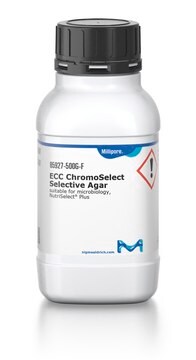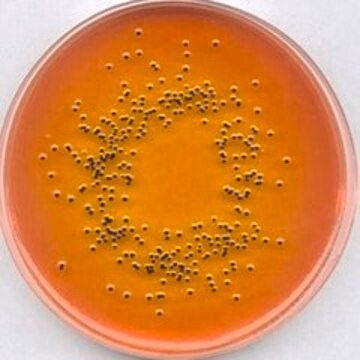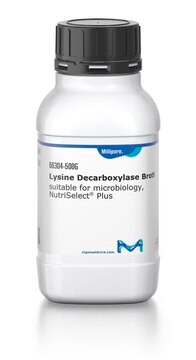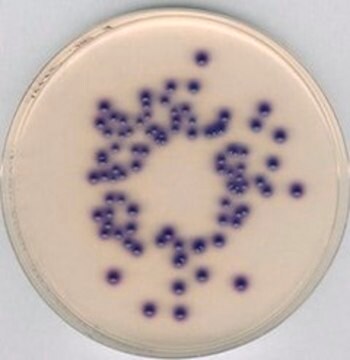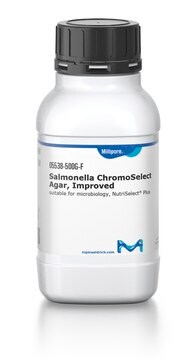67579
O157 Millichrome™ plus Agar
suitable for microbiology
Synonym(s):
E. coli O157 chromogenic agar
About This Item
Recommended Products
Agency
EP
JP
USP
Quality Level
Sterilization Compatibility
dry heat compatible
form
dry powder
shelf life
limited shelf life, expiry date on the label
composition
Agar, 15.0 g/L
Chromogenic Mix, 1.2 g/L
Chromogenic mix, 1.2 g/L
Peptone and yeast
extract, 13.0 g/L
Peptone & Yeast Extract, 13.0 g/L
manufacturer/tradename
MilliChrome™
technique(s)
microbiological culture: suitable
final pH
6.9±0.2 (25 °C)
solubility
deionized water: 29.2 g/L
application(s)
food and beverages
microbiology
shipped in
ambient
storage temp.
15-25°C
suitability
selective for bacteria: Escherichia coli O157
Related Categories
General description
Application
Preparation Note
- Disperse slowly 29.2 g of powder base in 1 L of purified water.
- Stir until agar is well thickened.
- Heat and bring to boil (100 °C) while swirling or stirring regularly.
Warning: If using an autoclave, do so without pressure.
Advice 1: For the 100 °C heating step, mixture may also be brought to a boil in a microwave oven: after initial boiling, remove from oven, stir gently, then return to oven for short repeated bursts of heating until complete fusion of the agar grains has taken place (large bubbles replacing foam).
Advice 2: if a more selective, and more specific, medium is needed, add a solution of Potassium Tellurite to obtain a final concentration of 2.5 mg/L at 45-50 °C.
Advice 3: in case of product samples containing a high load of Proteus, Cefixime can be added at 0.025 mg/L at 45-50 °C.
Advice 4 : in case of product samples containing a high load of Pseudomonas and/or Aeromonas, Cefsulodin can be added at 5 mg/L at 45-50 °C.
Step 2 (Pouring plates)
- Cool in a water bath at 45-50 °C, swirling or stirring gently.
- Pour into sterile Petri dishes.
- Let it solidify and dry.
Storage and Stability
Analysis Note
Legal Information
supplement
Storage Class Code
11 - Combustible Solids
WGK
WGK 3
Choose from one of the most recent versions:
Certificates of Analysis (COA)
Don't see the Right Version?
If you require a particular version, you can look up a specific certificate by the Lot or Batch number.
Already Own This Product?
Find documentation for the products that you have recently purchased in the Document Library.
Our team of scientists has experience in all areas of research including Life Science, Material Science, Chemical Synthesis, Chromatography, Analytical and many others.
Contact Technical Service
